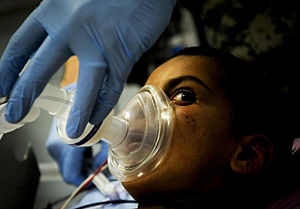
Back Narkose Afrikaans تخدير Arabic Anestesia AST Anesteziya Azerbaijani Анестэзія Byelorussian Анэстэзія BE-X-OLD Pemba'alan BEW Анестезия Bulgarian एनेस्थीसिया Bihari অবেদন Bengali/Bangla
This article needs additional citations for verification. (July 2022) |
| Anesthesia | |
|---|---|
 A child preparing to go under anesthesia | |
| Pronunciation | /ˌænɪsˈθiːziə, -siə, -ʒə/[1] |
| MeSH | E03.155 |
| MedlinePlus | anesthesia |
| eMedicine | 1271543 |
Anesthesia (American English) or anaesthesia (British English) is a state of controlled, temporary loss of sensation or awareness that is induced for medical or veterinary purposes. It may include some or all of analgesia (relief from or prevention of pain), paralysis (muscle relaxation), amnesia (loss of memory), and unconsciousness. An individual under the effects of anesthetic drugs is referred to as being anesthetized.
Anesthesia enables the painless performance of procedures that would otherwise require physical restraint in a non-anesthetized individual, or would otherwise be technically unfeasible. Three broad categories of anesthesia exist:
- General anesthesia suppresses central nervous system activity and results in unconsciousness and total lack of sensation, using either injected or inhaled drugs.
- Sedation suppresses the central nervous system to a lesser degree, inhibiting both anxiety and creation of long-term memories without resulting in unconsciousness.
- Regional and local anesthesia block transmission of nerve impulses from a specific part of the body. Depending on the situation, this may be used either on its own (in which case the individual remains fully conscious), or in combination with general anesthesia or sedation.
- Local anesthesia is simple infiltration by the clinician directly onto the region of interest (e.g. numbing a tooth for dental work).
- Peripheral nerve blocks use drugs targeted at peripheral nerves to anesthetize an isolated part of the body, such as an entire limb.
- Neuraxial blockade, mainly epidural and spinal anesthesia, can be performed in the region of the central nervous system itself, suppressing all incoming sensation from nerves supplying the area of the block.
In preparing for a medical or veterinary procedure, the clinician chooses one or more drugs to achieve the types and degree of anesthesia characteristics appropriate for the type of procedure and the particular patient. The types of drugs used include general anesthetics, local anesthetics, hypnotics, dissociatives, sedatives, adjuncts, neuromuscular-blocking drugs, narcotics, and analgesics.
The risks of complications during or after anesthesia are often difficult to separate from those of the procedure for which anesthesia is being given, but in the main they are related to three factors: the health of the individual, the complexity and stress of the procedure itself, and the anaesthetic technique. Of these factors, the individual's health has the greatest impact. Major perioperative risks can include death, heart attack, and pulmonary embolism whereas minor risks can include postoperative nausea and vomiting and hospital readmission. Some conditions, like local anesthetic toxicity, airway trauma or malignant hyperthermia, can be more directly attributed to specific anesthetic drugs and techniques.
- ^ "anaesthesia". Oxford English Dictionary (Online ed.). Oxford University Press. (Subscription or participating institution membership required.)